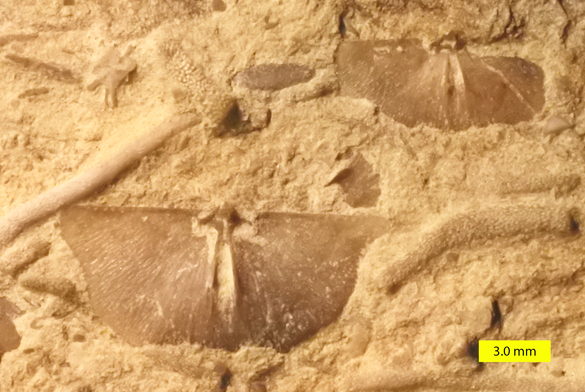 Usually I find fossils in the field or lab and then craft a Fossil of the Week entry around them. This time, though, I started with a paper and then searched for fossils to illustrate it. I found this recent paper very well done:
Usually I find fossils in the field or lab and then craft a Fossil of the Week entry around them. This time, though, I started with a paper and then searched for fossils to illustrate it. I found this recent paper very well done:
Bauer, J.E. and Stigall, A.L. 2016. A combined morphometric and phylogenetic revision of the Late Ordovician brachiopod genera Eochonetes and Thaerodonta. Journal of Paleontology 90: 888-909.
It does classic systematics on a group of brachiopods with the modern tools of morphometric and phylogenetic analyses. Its conclusions are direct and convincing: The genus Thaerodonta is synonymous with Eochonetes, and a variety of species are shifted around, solving problems that have lingered for over a century, Plus as a bonus, who can’t love a new species named Eochonetes voldemortus? So I set out to find specimens of this brachiopod group in our collections. Above are internal valve views of the brachiopod Eochonetes clarksvillensis (Foerste, 1912), showing characteristic denticles (little teeth) along the hinge line. Below are external valve views. Jen Bauer herself kindly confirmed the identifications!
These specimens come from the Waynesville Formation (Katian) exposed at Caesar Creek in southern Ohio, a place we have had many paleontology field trips. E. clarksvillensis is common in the Waynesville and overlying Liberty formations. Read much more about it in Bauer and Stigall (2016).
The genus Eochonetes was named by Frederick Richard Cowper Reed in 1917 from the Ordovician of Scotland. (The British Isles were not too far away from Ohio in the Late Ordovician.) Reed was born in London in 1869 and died in Cambridge, England, in 1946. I tried mightily but could find no images of him to enter into the digital archives of the web. He was a smart and diverse geologist, attending Trinity College, Cambridge, and winning important awards and scholarships. He was appointed assistant to the Woodwardian Professor of Geology at Cambridge in 1892, a position he kept until retirement. In 1901 he earned the Sedgwick Prize for his work on the rivers of East Yorkshire, wrote a book on the geology of the British Empire (much easier to do today!), and yet still found time to describe fossils in numerous papers.
The author of Eochonetes clarksvillensis is much better known to paleontologists of the Cincinnati region. It is August F. Foerste (1862-1936), who named Thaerodonta clarksvillensis in 1912. Foerste grew up and worked in the Dayton, Ohio, area, graduating from Denison University after publishing many papers as a student. He returned to Dayton after earning a PhD from Harvard, teaching high school for 38 years. When he retired he turned down a teaching position at the University of Chicago and instead worked at the Smithsonian Institution until the end of his life. He is one of the giants of the Cincinnati School of paleontology.
References:
Bauer, J.E. and Stigall, A.L. 2016. A combined morphometric and phylogenetic revision of the Late Ordovician brachiopod genera Eochonetes and Thaerodonta. Journal of Paleontology 90: 888-909.
Reed, F.R.C. 1917. The Ordovician and Silurian Brachiopoda of the Girvan District: Transactions of the Royal Society of Edinburgh 51: 795–998.




